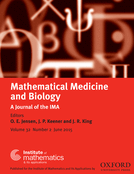-
PDF
- Split View
-
Views
-
Cite
Cite
Sean McGinty, Sean McKee, Christopher McCormick, Marcus Wheel, Release mechanism and parameter estimation in drug-eluting stent systems: analytical solutions of drug release and tissue transport, Mathematical Medicine and Biology: A Journal of the IMA, Volume 32, Issue 2, June 2015, Pages 163–186, https://doi.org/10.1093/imammb/dqt025
Close - Share Icon Share
Abstract
Drug-eluting stents have significantly improved the treatment of coronary artery disease. They offer reduced rates of restenosis compared with their bare-metal predecessors and are the current gold standard in percutaneous coronary interventions. Drug-eluting stents have been approved for use in humans since 2002 and yet, despite the intensive research activity over the past decade, the drug release mechanism(s) and the uptake into the arterial wall are still poorly understood. While stent manufacturers have focussed primarily on empirical methods, several mathematical models have appeared in the literature considering the release problem, the uptake problem and also the coupled problem. However, two significant challenges that remain are in understanding the drug release mechanism(s) and also the determination of the various parameters characterizing the system. These include drug diffusion coefficients and dissolution constants in the stent polymer coating as well as drug diffusion coefficients, binding/uptake rates and the magnitude of the transmural convection in the arterial wall. In this paper we attempt to address these problems. We provide analytical solutions which, when compared with appropriate experiments, may allow the various parameters of the system to be estimated via the inverse problem. The analytical solutions which we provide here for drug release in vitro may thus be used as a tool for providing insights into the mechanism(s) of release.



